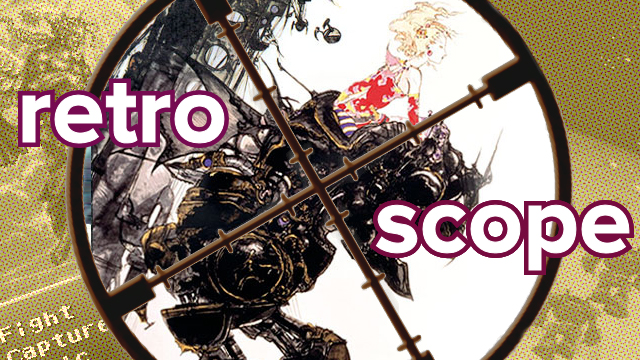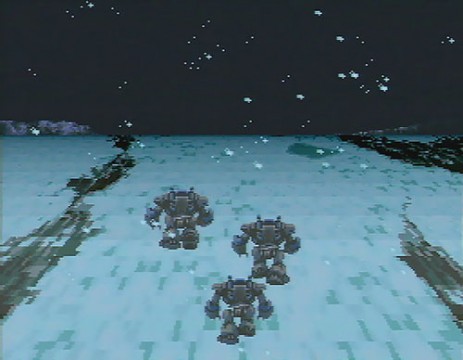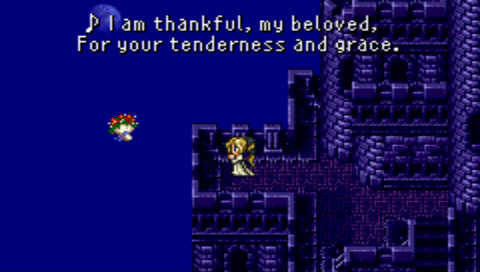
What’s there to say that hasn’t already been said about the work of art known as Final Fantasy VI? Square-Enix’s sixth installment in its coveted franchise took gamers by storm when it debuted on SNES in 1993, and it went on to capture an entirely new audience with its re-release on the original PlayStation some six years later in 1999. Though it gets overlooked by its younger, more well-known and vainglorious brother, the multimedia titan that is Final Fantasy VII, VI is often thought of as the more eloquent, silent beauty of the franchise– and for good reason.
I’m ashamed to admit that my first outing with VI wasn’t on its original platform of origin. At the time of its release on SNES (under the name Final Fantasy III in the US), I was eight years old, and my inattention was far too great to sit down with a sprawling RPG, so my first experience with the game was on PlayStation. Of course, I’d eventually go back and play it on SNES some years later, but what immediately struck me was how cinematic the game was. No, there weren’t any flashy CGI cutscenes like in the later games, but Final Fantasy VI didn’t need to rely on a bag of tricks to captivate its viewers. There was no illusionary needed, really. From that opening scene with the Magitek Armor wading through the densely falling snow to arrive in the game’s first town, Narshe, I immediately felt connected to the game’s universe.
I equate Final Fantasy VI to Star Wars in many regards, particularly in how rich, immersive, and alive its world feels. Right from the get-go, everything from the technology to the grumblings of Narshe’s residents, VI’s universe was one that looked like it had existed for millennia. Houses were tattered, people spoke of their histories, devices looked aged and worn… Simply put, VI showed us a planet that had been inhabited and walked on for countless generations long before we, the gamer, ever stepped foot on its digital soil. What’s most impressive about this, is one could pick up on these qualities just within the first ten minutes of the game– that’s an inspiring feat for a title that could only show you its world through the lens of a 16-bit microscope.
Where I draw another comparison to George Lucas’ space opera is in Final Fantasy VI’s huge cast of characters. While Terra is certainly the game’s main protagonist, like Luke was to Star Wars, she had a tremendous supporting cast that got nearly as much, if not completely equal, screen time. The supporting characters exuded personality, and better yet, had very distinct personalities that managed to mostly avoid the standard archetypes we too often see in these types of RPGs. Their motivations for embarking upon this epic quest felt genuine, and their banding together seemed natural and authentic. To pull together a cast as big as Final Fantasy VI’s and to actually make it work is an achievement rarely attained by developers in this genre. There are too many RPGs, particularly JRPGs, with throw-away characters, but not here. Edgar felt as integral to the story as Terra did, who felt just as necessary as Locke and on down the list.
Above all else, though, it’s the story that shines in Final Fantasy VI. It’s a narrative that felt new, though somehow familiar, and told of how light does defeat darkness no matter how seemingly impossible it appears. The sheer conviction and sincerity behind the game’s plot manages to constantly pull at the player’s heartstrings, and when Celes threw her bouquet off that balcony at the opera house halfway through the game, my heart skipped a beat and I actually gasped to relieve the welling up feeling that had slowly crept into my chest and throat. There aren’t many games that can elicit that kind of reaction from its customer.
The grand scope and design of Final Fantasy VI is unmatched. Just like Star Wars, the issues of the game’s world felt both big and small, beatable and unbeatable. Its vastness could not be estimated, rather it could only be felt and assumed, derived by the feeling of being lost in a world that was enchantingly foreign and yet strikingly relatable.
I’ll never forget my time with Final Fantasy VI because it was a time that felt incalculably magical. The game’s capacity for such wonderment and infinite charm are testaments to a style and design not frequently seen in today’s industry. The entire game is such a masterpiece, not because of the parts you can measure, but by those you can’t. All great pieces of art, in any form, go beyond what they show us visually. I’m inclined to believe this is because unadulterated exquisiteness can only be interpreted on so many cognitive levels before it becomes something beyond what we can comprehend and thereby articulate. The team behind Final Fantasy VI somehow knew how to include that unseeable, indescribable factor that makes the synapses in our brain fire on overload. Because of that, the only words that my feeble mind can come up with to aptly explain FFVI in its totality is: everlasting. That’s what Final Fantasy VI is to me; everlasting, eternal.




 ShareThis
ShareThis








